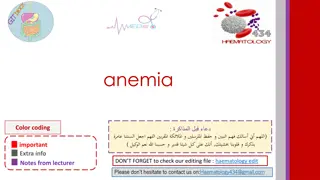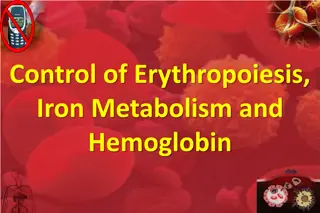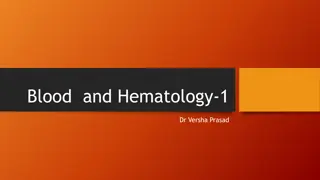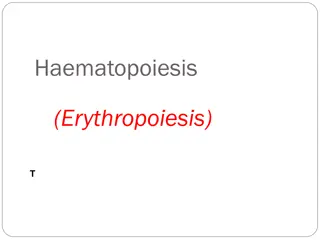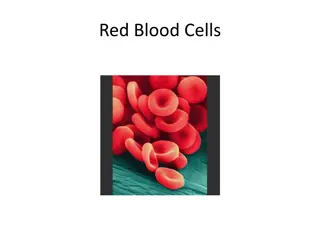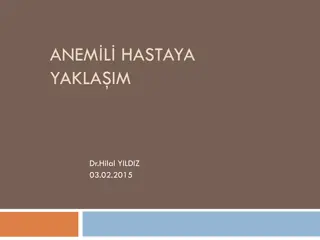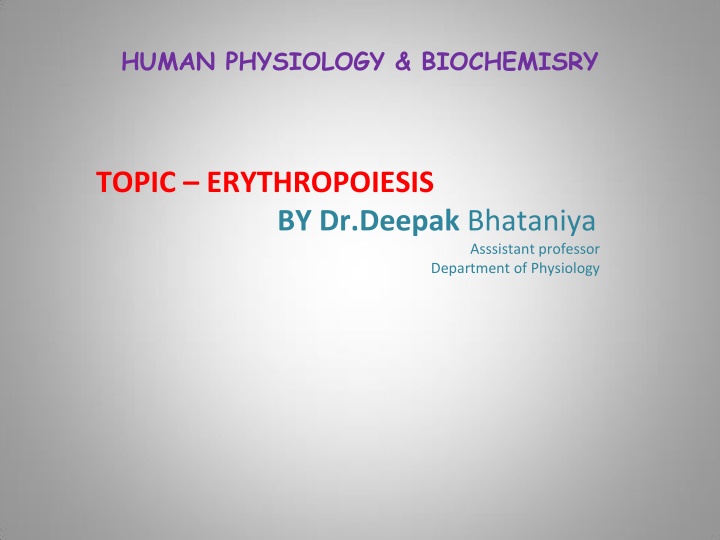
Erythropoiesis in Human Physiology
Explore the process of erythropoiesis, the formation of red blood cells, from embryonic life to adulthood. Learn about the sites of RBC production, different stages of erythropoiesis, features of mature RBCs, and the regulation of RBC production and erythropoietin hormone secretion in response to hypoxia.
Download Presentation

Please find below an Image/Link to download the presentation.
The content on the website is provided AS IS for your information and personal use only. It may not be sold, licensed, or shared on other websites without obtaining consent from the author. If you encounter any issues during the download, it is possible that the publisher has removed the file from their server.
You are allowed to download the files provided on this website for personal or commercial use, subject to the condition that they are used lawfully. All files are the property of their respective owners.
The content on the website is provided AS IS for your information and personal use only. It may not be sold, licensed, or shared on other websites without obtaining consent from the author.
E N D
Presentation Transcript
HUMAN PHYSIOLOGY & BIOCHEMISRY TOPIC ERYTHROPOIESIS BY Dr.Deepak Bhataniya Asssistant professor Department of Physiology
The process of formation of RBCs is called Erythropoiesis
Learning Objectives of Todays Lecture At the end of this lecture student should be able to recognize: Sites of Erythropoiesis Main features of different stages of Erythropoiesis Features of mature RBCs The regulation of RBC production and erythropoietin hormone secretion in response to hypoxia
Site of RBC Production Early weeks of embryoniclife: Nucleated RBCs - Yolk sac
Site of RBC Production, Cont. Middle trimester of gestation: Liver form blood cells (mainly) Spleen + lymph nodes form blood cells Last month of gestation and afterbirth: - Red bone marrow (exclusively)
RBC Production after birth The bone marrow of all bones - 5 years Marrow of the long bones (except for the proximal humerus and tibia) No more red blood cells are produced after the age of 20 years. Most RBCs continue to be produced in the marrow of the membranous bones, such as Vertebrae, Sternum, Ribs, and Ilia
Relative rates of red blood cell production in the bone marrow of different bones at different ages.
Genesis of RBC (Hemocytoblast) (1) Myeloid stem cell (2) Lymphoid stem cell 10
Genesis (Production) of RBC Pluripotential hematopoietic stem cell (PHSC). Committed stem cell that produces erythrocytes is called Colony-forming unit erythrocyte, CFU-E Factors: Factors: Growth inducers, such as interleukin-3 Differentiation inducers.
Stages of Erythropoiesis PHSC Comittes stem cell, CFU-E Proerythroblast Basophil erythroblast Polychromatophil erythroblast Orthochromatophil erythroblast Reticulocyte Erythrocyte
Maturation Times Erythroblasts actively synthesize Hb. They are categorized on the basis of total size, the amount of Hb present, and the size of nucleus.
Erythropoiesis RBC development is characterized by: A decrease in cell size A disappearance of nucleus An appearance of hemoglobin 14
Proerythroblast No hemoglobin Nucleus 12 um Contain nucleoli
Basophil erythroblast Early Normoblast Nucleoli disappear Show mitosis Cytoplasm deep blue Increase in RNA Hemoglobin starts appearing Little Hb
Polychromatophil erythroblast Late Normoblast Nucleus smaller Coarse Chromatin Hemoglobinincreases
Orthochromatic Erythroblast Normoblast Contains a small dense nucleus Nuclear lysis and Nuclear extrusion
Reticulocyte Reticulum Remnant of ER & GA Contains RNA inthe cytoplasmto: Synthesize Hb synthesize other proteins Few Mitochondria Young RBCs (80% Hb) < 1 % of RBCs
Transfer of RBC to Circulation RBC pass from the bone marrow into the blood capillaries By Diapedesis (squeezing through the pores of the capillary membrane).
Erythrocytes Round, biconcave, disc shaped. Smooth contours Diameter 7- 8 um. Normally no variation in size and shape. Can deform easily Hb =34g/dl of cells Hb= 14-16 g/dl in the blood
STRUCTURE OF RBC Negative surface charge Bag of fluid with dissolved substances and hemoglobin Membrane Outer glycoprotein coat Lipid bilayer (PL 55%,Cholesterol 45%) Inner protein molecules cytoskeleton Spectrin, Actin, Ankyrin etc.
ENERGY METABOLISM Less energy required Utilize Glucose for energy by: - Anaerobic glycolysis - Pentose phosphate pathway
RBC Count MALE MALE : : 5,200,000 300000 per mm3(uL). FEMALE FEMALE : : 4,700,000 300000 per mm3(uL). LIFE SPAN: 120 Days.
Regulation of RBC production Erythropoiesis is stimulated by erythropoietin (EPO) hormone produced by the kidney in response to hypoxia (low oxygen in the blood) Hypoxia caused by: Low RBC count (Anaemia) Hemorrhage High altitude Prolong heart failure Lung disease 26
Tissue oxygenation and RBC formation CFU-E 27
Erythropoietin (EPO) Glycoprotein 90% of EPO is produced from peritubular fibroblasts in the renal cortex and 10% from the liver Renal failure? Stimulate the growth of early stem cells Can be measured in plasma & urine High levels of erythropoietin Anemia, hemorrhage High altitude Heart failure Lung Disease (Result in polycythemia)
Role of EPO EPO stimulates increased cell division rates in erythroblasts and stem cells that produce erythroblasts. EPO speeds up the maturation of RBCs by accelerating the rate of Hb synthesis. Under maximum EPO stimulation, bone marrow can increase the rate of RBC production tenfold. Blood doping? 30
Main Features - Stages ofErythropoiesis Proerythroblast Basophilic Erythroblast Polychromatophil Erythroblast Orthochromaticerythroblast Reticulocyte Erythrocyte
Erythropoiesis TEXTBOOK OF MEDICAL PHYSIOLOGY GUYTON & HALL 11THEDITION 1


